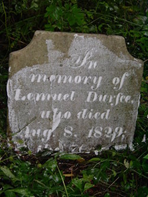
Lemuel Durfee Sr., son of Gideon Durfee and Anne (Anna) Bowen, was born on April 18, 1759 on the eastern shore of Narragansett Bay in Tiverton, Newport County, Rhode Island. (His first name “Lemuel” is a biblical name found in Proverbs 31:1, 4.) Rhode Island had been home to the Durfee family for generations. Members of the Nathan Harris family were acquaintances and friends with the Durfees in Rhode Island. Both families later resided in the district of Cambridge, New York before moving to Palmyra.
American Revolutionary War
The Durfees had a military tradition in their family. Gideon Durfee, father of Lemuel Sr., held the commission “lieutenant of militia” from George II, King of England. Gideon changed his loyalty to the English crown in the Revolutionary War and served as a minuteman for the American Revolution. At age forty-three, he served guard duty in Newport, Rhode Island from October 23, 1871 to November 7, 1871. He received three pounds and four shillings for his military service.[1]
Lemuel Sr. and Nathan Harris, who was a year younger than Lemuel Sr., enlisted in the militia and served from 1777 to 1778. Lemuel Sr. served in three separate Rhode Island regiments.[2] From November 15, 1777 to August 1778, he was a private in the Captain Christopher Manchester Company. In August 1778, he was a private in the Captain Richard Durfee Company. By the end of 1778, he was a private in the Captain Bailey Company. His wages per month were £2. Lemuel Sr. and his brother Earle fought in the Battle of Rhode Island.
Family Man
Lemuel Sr. married Prudence Hathaway on August 29, 1784 in Adams, Berkshire County, Massachusetts (Prudence was born on May 24, 1766 in Adams, Massachusetts.) Their marriage certificate reads—
This is to certify that Lemuel Durfee of Cambridge in the State of New York and Prudence Hathaway of Adams in the County of Berkshire and Commonwealth of Massachusetts were lawfully joined together in marriage at Adams aforesaid on the twenty-fourth day of August 1784 by James Barker, Justice of the Peace.[3]
The marriage of Lemuel Sr. and Prudence Hathaway was a Quaker marriage, which means written proposals of marriage were presented before the monthly meeting of the “Friends” society and approved. “In due time, the young couple married themselves, according to the Friends’ tradition in a public congregation.”[4]
To the union of Lemuel Sr. and Prudence were born twelve children. Eleven of their children lived out their lives in Palmyra. This fact indicates that the Durfee children enjoyed familial ties and found financial stability in the Palmyra community.
The Move to Palmyra
Nathan Harris and his family were acquaintances and friends with the Durfee family in Rhode Island. Both families later resided in the district of Cambridge, New York before moving to Palmyra in the same year. Gideon Durfee, father of Lemuel Durfee Sr., was the first in his family to settle in Palmyra. It is likely that Gideon moved his family to New York to be closer to relatives who established a Quaker settlement in Farmington, New York, nine miles from Swift’s Landing (Palmyra).
In 1793, Gideon Durfee and his brother Edward walked from Albany to Palmyra. Gideon paid John Swift, the founder of Palmyra, “coin” for 1,600 acres in the North Creek section of the village. Gideon’s payment enabled Swift to meet his indebtedness to secure warranty deeds for land which later became the townships of Macedon and Palmyra.[5]
Gideon and Edward Durfee were followed by at least eight of their siblings to Palmyra. More important to our story was the arrival of Lemuel Durfee Sr. in Palmyra in late 1793. On November 5, 1793, Humphrey Sherman of Yeoman, New York, and Lemuel Sr. entered into an indenture for 200 acres in Lot 23 bordering the property of Gideon Durfee.[6] It took Lemuel Sr. until February 19, 1799, to work off the fifty pounds owed to satisfy clear title to the acreage.
In an indenture written on November 5, 1793 between Lemuel Sr. and Humphrey Sherman, Lemuel Sr. purchased property worth “80 pounds of New York Currency” in Palmyra that bordered the properties owned by Nathan Harris and Gideon Durfee. On that property, Lemuel Sr. hired Alvin Smith and others to build a house at the intersection of Maple Avenue and Jeffrey Road. The house was razed in 2002.
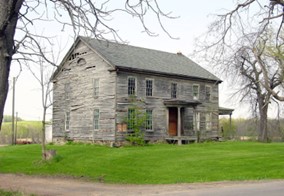
Lemuel Sr.’s closest neighbors were his parents and brothers Job, Edward, Stephen, and Gideon Jr. As Lemuel Sr.’s children married, they also remained close neighbors. Other close neighbors included Martin and Lucy Harris, who lived on Maple Street. All of these neighbors farmed, tilled the land, ran small businesses, and raised small farm animals.[7]
Quakers in the Greater Palmyra Area
A significant number of people in Palmyra were members of the Society of Friends (Quakers). A local historian assessed the Quaker influx in Western New York by writing, “Throughout several of the towns in this part of the state there dwelt families of the society; in Farmington about thirty families, and in Palmyra about forty-five.”[8]
The Quaker meetinghouse in Palmyra was built in 1800 in the wilderness area of Lemuel Sr.’s farm, about two miles north of the Palmyra village.[9] Lemuel Sr. donated land for the Quaker house on Walker Road.[10] Characteristics of Quaker worship in Western New York were as follows—
They had no music in their meetings, and they put great emphasis on the Holy Spirit or inner light to guide them in their conduct and correct them in their errors. They accepted no paid salary in their ministry: neither was their Clergy educated in Theological Seminaries. They were men and women who felt called to preach, and spoke as the spirit gave them utterance. The Friends never hurried in their worship, but literally waited on the Lord. If no one in the Meeting was prompted to speak, they would sit in silence the usual length of time. They all kept quiet until one of the Elders of the High Seats extended his right hand in greeting to the one who sat nearest to him, which was the signal for breaking up the Meeting (a benediction, so to speak).[11]
Among those attending Quaker meetings were members of the extended Durfee family and members of the Nathan and Rufus Harris families. Also attending the Quaker meetings was George Crane, named in the Fayette Lapham article in 1870.
On June 6, 1824, Lemuel Sr. and his wife Prudence signed over more land “expressly intended for a meetinghouse lot for Friends for their accommodations in public worship or transacting the affairs of the society or teaching or school and never to be used for any other purpose whatsoever on pain of forfeiting” to Peter Harris and Stephen Durfee, who acted in behalf of the Religious Society of Friends.[12] As further evidence of his commitment to Quakerism, the name of Lemuel Durfee Sr. appears on the Quaker Census of 1828.[13]
A Man of High Standing in Palmyra
The first town meeting of Palmyra was held at the Gideon Durfee home on Tuesday, April 5, 1796.[14] In 1959, the state of New York funded the installation of more than 2,800 historical site markers throughout the state, including 35 in Wayne County. A blue and yellow steel-cast sign is in the front yard of the Gideon Durfee farmhouse. It reads, “Site of Pioneer Home of Gideon Durfee built 1811.”
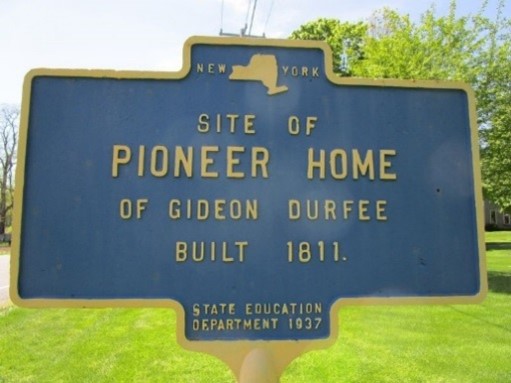
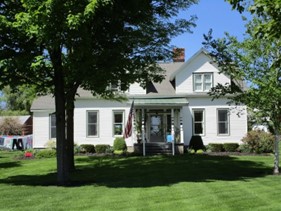
A second sign across the road from the Gideon Durfee farmhouse reads “Rope Walk. Here rope was manufactured in 500 foot lengths. It was used on the Albany Schenectady Railroad.” The Durfee Rope Walk was started by Gideon Durfee and inherited by Lemuel Durfee Sr.
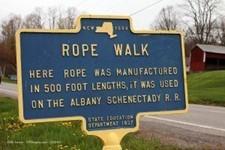
Civic Service. Through the years, Lemuel Sr. was elected to positions of trust in the Palmyra village—commissioner/overseer of highways (1803–1804, 1807, 1810, 1818, 1821, 1823), assessor (1803–1804), collector (1817), and overseer of the poor (1817).[15] His name appeared on a jury list in 1808 and 1812.[16] Lemuel Sr. interrupted his civic service to enlist in the War of 1812.[17] Due to age, his military service was more honorific than active.
Man of Means. Lemuel Sr. yielded 50 bushels of corn per acre on his 200 acre farm. The market for his produce was in Schenectady, New York. He shipped corn via the Ganargua Creek and other waterways, including the Erie Canal. His name appeared on the tax assessment roles of Palmyra, board of trustee minute books, and board of education minutes.
Lemuel Sr. and his brother Edward inherited a rope walk from their father Gideon Durfee.[18] A rope walk is a long building where men walk its length to twist hemp into rope. Rope from the Durfee Rope Walk was exported throughout the eastern United States.[19]
In their youth, Lemuel Sr.’s sons were expected to help prepare for market produce grown on the Durfee farm. His sons were also expected to work at the Durfee Rope Walk.[20] In addition, they were to help operate the Durfee Cider Mill. By so doing, Lemuel Sr. and his sons became acquainted with customers who were not Quakers, such as Alexander McIntyre, Eli Seymour, Pliny Sexton, Jeremiah Hurlbut, Henry Jessup, and Gain Robinson. They also became acquainted with common laborers such as Joseph Smith Jr., Hyrum Smith, and Samuel Harrison Smith.
Land Entrepreneur. Between 1799 and 1826, Lemuel Sr. purchased much acreage in Ontario County. Fourteen deeds bearing his signature are located in the Ontario County Historical Society.[21] One deed shows that on April 23, 1808, Lemuel Sr. and his son Isaac entered an indenture with William Peters of Adams, Massachusetts to purchase property in the southwest portion of Lot 47 in Palmyra for $250.[22]
Lemuel Durfee Account Farm Book, August 3, 1825 to July 10, 1829
The “Lemuel Durfee Account Farm Book, August 3, 1825 to July 10, 1829” lists small transactions.[23] The forty-six-page ledger of transactions reveals that Lemuel Sr. ran a cider mill and owned cattle. It also reveals, he rented out his cider mill in exchange for products, such as apples and cheese. Typical entries in the account book describe buying and selling farm produce and livestock.
More important than what was transacted are the names of those who Lemuel Sr. had business dealings with—Alexander McIntyre, Martin Harris, Preserved Harris, Eli Seymour, Daniel Haggart, Pliny Sexton, Jeremiah Hurlbut, Henry Jessup, Gain Robinson, and Roswell Nichols. Lemuel Sr. also had dealings with Joseph Smith Jr., Hyrum Smith, and Samuel Harrison Smith. Ralph Carter, owner of the Durfee Farm in July 1992, claimed the Smiths dug and rocked eleven wells on the Lemuel Sr. property.
The Smith Farm and Lemuel Durfee
Lucy Mack Smith wrote of circumstances surrounding the loss of the Smith farm in 1825. In her writings of this incident, Lemuel Sr. plays a prominent role—
By the request of my husband, I went to see an old Quaker, a gentleman with whom we had been quite intimate since our commencement on the farm, and who had always seemed to admire the neat arrangement of the same. We hoped that he would be both able and willing to purchase the place that we might at least have the benefit of the crops that were upon the ground, as he was a friend and would be disposed to show us favor. But we were disappointed, not in his will or disposition, but in his ability. He had just paid out to the land agent all the money he could spare, to redeem a piece of land belonging to a friend in his immediate neighborhood. If I had arrived at his house thirty minutes sooner, I would have found him with fifteen hundred dollars in his pocket.
When I rehearsed to him what had taken place, he was much distressed for us, and very much regretted his inability to relieve our necessity. He said, however, “If I have no money, I will try to do something for you, and you may say to your husband, that I will see him as soon as I can, and let him know what the prospect is.” . . .
The old gentleman, as soon as I left, started in search of some one that could afford us assistance, and hearing of a Mr. [Lemuel] Durfee, who lived four miles distant, he came the same night, and directed us to go and see what he could devise for our benefit.
Who was “the old Quaker, a gentleman with whom we had been quite intimate since our commencement on the farm, and who had always seemed to admire the neat arrangement of the same?” There was only one old Quaker who had more money and land than Lemuel Sr. at the time: George Crane, who surveyed properties owned by Lemuel Sr. in Palmyra and Macedon. Crane was mentioned by Fayette Lapham in his 1870 article.
Back to the Lucy Mack Smith account—
Accordingly, my husband started without delay for Mr. Durfee’s, and arrived at his house before daylight in the morning. He sent my husband three miles further, to one of his sons, who was high sheriff [Lemuel Durfee Jr.], instructing him to say to the young man that his father wished to see him as soon as possible. Mr. Durfee, the younger, was obedient to the call. Immediately after he arrived at his father’s, the three proceeded together to see the farm, and arrived about ten o’clock a.m. They tarried a short time, then rode on to see the agent and those villains who held the deed of our place.[24]
On December 20, 1825, Lemuel Sr., Lemuel Jr., and Joseph Smith Sr. went to Canandaigua, where Lemuel Sr. purchased the Smith farm for $1,135.25. Under Lemuel Sr.’s ownership, the Smiths became “renters,” being allowed to use the farm and remain in the frame home.[25] According to Lucy Mack Smith, Lemuel Sr. “gave us the privileage [sic] of the place one year with this provision that Samuel our 4th son was to labor for him 6 months.” An entry in the Lemuel Sr. Farm Account Book for April 16, 1827 reads: “S. Harrison Smith Son of Joseph Smith began to Work for me by the Month. Is to Work 7 months for the use of the place Where Said Joseph Smith lives.”[26]
Last Will and Testament
On July 12, 1826, about seven months after acquiring the Smith property, Lemuel Sr. wrote his Last Will and Testament which begins—
In the name of God Amen! I Lemuel Durfee of the town of Palmyra, County of Wayne and state of New York considering the uncertainty of this mortal life and being of sound and judged mind and memory (helped be, Almighty God for the same) do make and publish this my last Will and testament in manner and form following: First I resign my soul to God who gave it to me and my body to the dust from whence it came . . .
Lemuel Sr. then designates how he wants his personal and real wealth divided among family members. We learn from his will, it would have been advantageous to be one of Lemuel Sr.’s sons than one of his daughters. Of greater interest to us is how Lemuel Sr. wanted the Joseph Smith Sr. farm divided. Eight children were to inherit part of the Smith farm. His will is paraphrased as follows—
1. “I give and bequeath unto my beloved wife Prudence Durfee the use of one third part of my home farm (85 acres and 50 dollars) during her natural life excepting eighty five acres on the East side of said farm. (This acreage bordered the farm of Peter Harris, brother of Lucy Harris) . . . devised to my daughter Prudence Murphy including the north square room and fire place on the lower floor and the north next bedroom. (The division suggests that daughter Prudence is living in the same house with her mother and is taking care of her.) Lemuel Sr. also “bequeath[s] unto my said wife all the household furniture to be by her used so long as she remains my widow.” He also “bequeath[s] unto my said wife Prudence five good cows, and a suitable riding horse, two good sheep, and two hundred dollars in money to be paid to her by my executory as convenient after my decease.”
2. To his son Isaac Durfee, Lemuel Sr. bequeathed “the farm on which he now resides containing according to a survey made by George Crane (a man mentioned in the 1870 Fayette Lapham article).
3. To his son Lemuel Jr., Lemuel Sr. bequeathed farmland that bordered his son Isaac Durfee’s farm in Palmyra. He also bequeathed “the farms on which he now resides containing according to a survey made by George Crane” and hundreds of additional acres of farmland in Palmyra and Macedonia.
4. To his son Oliver Durfee, Lemuel Sr. bequeathed 195 acres in Palmyra.
5. To his son Bailey Durfee, Lemuel Sr. bequeathed 25 acres in Palmyra plus his house and farm (263 acres) except the 85 acres given to his daughter Prudence. It is stipulated that Bailey “should aid and assist his mother take good care of her in sickness and in health, so long as she shall remain my widow.”
6. To his daughter Phebe Durfee, Lemuel Sr. bequeathed 85 acres in Palmyra and 50 dollars.
7. To his daughter Mary Durfee, Lemuel Sr. bequeathed 90 acres in Ontario County and 50 dollars.
8. To his granddaughter Lucia Durfee, Lemuel Sr. bequeathed 55 acres in Palmyra.
9. To “the lot of land called the Execution lot situated in the north West corner of the town of Manchester in the county of Ontario being the lot on which Joseph Smith now lives containing about one hundred acres of land and the awaits . . . to be distributed as follows amongst my heirs (viz) the third thereof to be equally distributed among my four sons Isaac, Oliver, Lemuel and Bailey and the remaining third to be distributed among my four daughters Phebe, Prudence, Mary, and Irene in equal proportions likewise to sell and …the remaining fifteen acres of land which is not disposed of in the before mentioned lots in the town of Ontario and distribute the proceed of the sale in the same manner as heretofore mentioned.
10. To his daughter Irene Durfee Bates, Lemuel Sr. bequeathed $100.
Lemuel Sr.’s will then instructed that debts are to be paid before appointing “Prudence Durfee executrix and my son Oliver Durfee and my son Lemuel Durfee executors.” This was done in the presence of three men, one of them being Peter Harris.
The Year 1828
On June 14, 1828, Martin Harris carried the 116 pages to Palmyra. He had the manuscript in his possession until about July 7, 1828. During those weeks, Martin showed the manuscript to any “prudent” person who called. Would Lemuel Sr. be considered a prudent person in 1828?
Lemuel Sr. was age sixty-nine when the 116 pages were stolen. His home was on Maple Street, the same street as the Martin Harris home. Was Lemuel Sr. the “particular friend” who was shown the pages? Let us consider—
In mid-June 1828, Martin Harris took his wife Lucy to visit her relatives who lived some 10 to 15 miles from Palmyra. Martin’s stay with Lucy’s relatives was brief, for he had pressing business matters and a jury duty obligation in town. As he made preparations to return to Palmyra, his wife, wishing to extend her visit, declined to accompany him. Martin journeyed home by himself. Once at home—
A very particular friend of his made him a visit, to whom he related all that he knew concerning the Record. The man’s curiosity was much excited, and, as might be expected, he earnestly desired to see the manuscript. Martin was so anxious to gratify his friend, that, although it was contrary to his obligation, he went to the drawer to get the manuscript, but the key was gone. He sought for it some time, but could not find it. Resolved, however, to carry his purpose into execution, he picked the lock.[27]
Rather than further repeat the familiar story of the marred bureau, let us consider the phrase “a very particular friend.” When we greet each other in a church setting, we say “brother” or “sister.” When a Quaker greets someone, they say “friend.” Who was the “very particular friend?” Five of the individuals who could have been shown the 116 pages were Martin’s relatives and Quakers, so it is possible that Peter Harris, brother of Lucy Harris, was the “very particular friend.” However, Martin would likely refer to Peter as a relative, not as a “particular friend.”
Assuming that the “very particular friend” Martin wanted to impress was a Quaker, the one Quaker with money in Palmyra, viewed as the patriarch of the Quaker congregation, was Lemuel Sr., who had also proven himself to be a “particular friend” of the Joseph Smith Sr. family in 1828 by allowing them to stay on property he owned.
The Lemuel Durfee Farm Account Book has interesting notations about the Joseph Smith Sr.’s sons during this period:
June 18, 1828 “Credit by Hiram & Harrison Smiths a hoeing one day a piece.”
June 20, 1828 “Joseph and Harrison Smiths Dr. To the Liqure of three barrels of cidar at 9/0 per barrel $3.38.”
July 7, 1828 “Credit by J. Smith & Rockwell by hoeing the three days.”
July 20, 1828 “Jos. Smith & Harrison Smiths Cr. By Work binding Wheat one day of William and three days of Harrison Work.”
August 7, 1828 “Credit [by] Rockwell to two days Mowing for me by Harrison Smith by three days a Mowing for me.”
An unusual entry was made on June 28, 1828: “Dr. Ely Seymour to the liqure [liquor] of one barrel of cider. His son George Seymour is to pay for cider $1.25.” This entry was written during the time when Martin Harris had the 116 pages in Palmyra. Why is this significant? The mother of Pliny Sexton (the banker with a vault) married Eli Seymour after the death of her first husband.
At this point, we move to the William Hine interview published in Arthur Deming’s Naked Truths about Mormonism (Oakland, CA: Deming & Company, 1888). In the interview, Hine claimed the 116 pages were passed to “a certain Dr. Seymour”—
W. R. Hine: “Martin’s wife cooked for them [Joseph Smith, Martin Harris, and Oliver Cowdery], and one day while they were at dinner she put one hundred and sixteen pages, the first part they had translated, in her dress bosom and went out. They soon missed the one hundred and sixteen pages and followed her into the road and demanded them of her. She refused, and said if it was the Lord’s work you can translate them again, and I will follow you to the ends of the earth. Dr. Seymour came along and she gave them to him to read, and told him not to let them go.[28]
Historian Dan Vogel believed that the Dr. Seymour in the Hine/Deming reference was Ezra Seymour of Colesville.[29] What Dan Vogel did not know was the mother of Pliny Sexton married Eli Seymour of Palmyra, and there is a direct connection between Eli Seymour and Ezra Seymour.
Lemuel Sr. had only thirteen months to live after the pages were stolen. When an older person nears death, their world typically narrows to a few close friends and family, with family taking precedence over friends. If Lemuel Sr. was shown the 116 pages by Martin Harris, who would he have told? The Quaker minister Peter Harris, brother of Lucy Harris, is a possibility. The Harris property bordered Lemuel Sr.’s farm. George Crane, the well-to-do Quaker, is another possibility. What about Lemuel Sr.’s sons? He selected as his executors his fourth son, Oliver Durfee, and his sixth son, Lemuel Jr., even though his other sons lived on property near him. His daughter Prudence lived in his home. If Lemuel Sr. told a family member, the likely suspects are his daughter Prudence and his sons Oliver and Lemuel Jr. The most likely is his son Lemuel Jr., because Lemuel Sr. trusted Lemuel Jr. to accompany him on the legal matter of purchasing the Joseph Smith Sr. farm and named him executor of his estate. When the pages were stolen, Lemuel Jr. was age twenty-seven. To put that in perspective, suspect Flanders Dyke was age twenty-nine.
Thirteen months after the manuscript was stolen, Lemuel Sr. died on August 8, 1829 in Palmyra at age seventy-one.[30] According to his Last Will and Testament, Lemuel Sr. bequeathed farmland to Lemuel Jr. bordering Isaac Durfee’s farm in Palmyra. He also bequeathed “farms on which he now resides in Macedonia,” and additional farmland in Palmyra and Macedonia. In conclusion, Lemuel Jr. became land-rich at the death of his father.
Roswell and Mary Durfee Nichols
The agreement between Lemuel Sr. and Joseph Smith Sr. for the Smith family to stay in the frame home ended in 1829, when Lemuel Sr.’s daughter, Mary Durfee Nichols, and her husband, Roswell Nichols, desired to move into the Smith farmhouse. According to the Last Will and Testament of Lemuel Sr., Mary stood to inherit a portion of the Joseph Smith Sr. property. The Joseph Smith Sr. family were evicted by Lemuel Durfee Jr., the “high sheriff” in Palmyra.[31]
Notice the timing of the eviction. Lemuel Sr. was within months of his death. No doubt, his world was becoming smaller—few friends, family ever more important, his health of concern, and his financial affairs turned over to Lemuel Jr.
Mary Durfee and Roswell Nichols married in 1822 and resided in Pultneyville, New York where three of their children were born.[32] In 1828, they moved to Palmyra. The Nichols were near neighbors to the Joseph Smith Sr. family in 1828. They continued being neighbors when the Smiths moved into the Hyrum Smith family’s log house in 1829. It does not appear that being near neighbors endeared the Smiths to the Nichols. In 1833, Roswell Nichols gave a sworn affidavit damaging the Smiths’ reputation. The affidavit was later printed in Mormonism Unvailed.
Manchester, Ontario County, Dec. 1st, 1833.
I, Roswell Nichols, first became acquainted with the family of Joseph Smith, Sen. nearly five years ago, and I lived a neighbor to the said family about two years. My acquaintance with the family has enabled me to know something of its character for good citizenship, probity and veracity—For breach of contracts, for the non-payment of debts and borrowed money, and for duplicity with their neighbors, the family was notorious.
Once, since the Gold Bible speculation commenced, the old man was sued; and while the sheriff was at his house, he lied to him and was detected in the falsehood. Before he left the house, he confessed that it was sometimes necessary for him to tell an honest lie, in order to live. At another time, he told me that he had received an express command for me to repent and believe as he did, or I must be damned, I refused to comply, and at the same time told him of the various impositions of his family. He then stated their digging was not for money but it was for the obtaining of a Gold Bible. Thus contradicting what he had told me before: for he had often said, that the hills in our neighborhood were nearly all erected by human hands—that they were all full of gold and silver. And one time, when we were talking on the subject, he pointed to a small hill on my farm, and said, “In that hill there is a stone which is full of gold and silver. I know it to be so, for I have been to the hole, and God said unto me, go not in now, but at a future day you shall go in and the hook [will] open, and then you shall have the treasures.” He said that gold and silver was once as plenty as the stones in the field are now—that the ancients, half of them melted the ore and made the gold and silver, while the other half buried it deeper in the earth, which accounted for these hills. Upon my enquiring who furnished the food for the whole, he flew into a passion, and called me a sinner, and said he, “You must be eternally damned.” I mention these facts, not because of their intrinsic importance, but simply to show the weak mindedness and low character of the man.
—Roswell Nichols[33]
Death of Lemuel Durfee Sr.
Lemuel Sr. died at 4:30 p.m. on August 8, 1829 in Palmyra at age seventy-one, approximately one year after the loss of the 116 pages.[34] He was buried in his family’s plot in the Gideon Durfee Burying Ground located behind the house at 3639 North Creek Road. The cemetery contains the remains of over two hundred people, including many of the Durfees and Lucy Harris, wife of Martin Harris. Less than ten headstones can still be seen in the cemetery. Although Lemuel Sr. bequeathed $300 for the perpetual care of the cemetery, it is now in a state of ruin. A marker was placed in the cemetery by the Cape Sebastian, Oregon Chapter of the Daughters of the American Revolution to honor Gideon Durfee and his wife Anna.
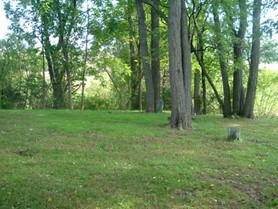
On August 31, 1829, Isaac Hussee and Peter Harris took an oath to appraise Lemuel Sr.’s estate. This suggests the respect that the Quaker community in Palmyra had for Peter Harris. The inventory of Lemuel Sr.’s estate listed an unpaid note from Joseph Smith Sr. and Abraham Fish for $37.50, plus $1.42 in interest, which totaled $38.92.[35] Lemuel Durfee Jr., an executor of the Lemuel Sr. estate, entered a plea (lawsuit) before Justice Nathan Pierce in Manchester against Smith and Fish for monies owed from the note. The issue was resolved on August 28, 1830 when Lemuel Jr. was awarded $42.04.[36]
On April 9, 1834, the executors of the Lemuel Sr. estate deeded the former Joseph Smith Sr. farm and frame house to Mary Nichols, daughter of Lemuel Sr., for $2,000.[37]
The widow of Lemuel Sr., Prudence Hathaway Durfee, died on April 13, 1849 at age eighty-three. Her Last Will and Testament was written on December 16, 1833.
Children of Lemuel Sr. and Prudence Durfee
In the Durfee Family Bible are names and birthdates of each child. Copies of the bible pages are housed in the Palmyra Community Library.
1. Isaac F. Durfee (1785–1855). He was a brother-in-law of Abner Cole. He served the Palmyra community from 1810 to 1820 as an overseer of highways, overseer of the poor, and a commissioner of highways.
2. Bailey Durfee (1787).
3. Phebe Durfee (1788–1875). She was born in Tiverton, Rhode Island. She married Thomas M. Young on February 9, 1809 in Palmyra. She died in Marion, Wayne County, New York.
4. Pardon Durfee (August 10, 1789–August 10, 1814). He owned the first public inn (tavern) in Palmyra. He served the Palmyra community from 1799 to 1821 as an overseer of highways, supervisor, pound master, school commissioner, and justice of the peace. He later ran the Durfee Rope Walk.
5. Oliver Durfee (1792–September 10, 1850). He served the Palmyra community from 1816 to 1827 as an overseer of highways. He owned a warehouse in Palmyra until it was destroyed by fire.
6. Stephen Durfee (June 15, 1794–August 5, 1818).
7. Prudence Durfee (March 29, 1796–April 7, 1872). She married John Hussey in 1815.
8. Mary Durfee (February 10, 1799).
9. Lemuel Durfee Jr. (March 1, 1801–1871).
10. Irene Durfee (September 30, 1803–October 9, 1829). She married Orland Bates on December 25, 1822.
11. Lucina Durfee (November 29, 1805–February 1, 1826). She married George W. Smith on October 11, 1825 in Palmyra.
12. Bailey Durfee (June 8, 1809–December 21, 1864). He married Abigail B. Reeves on December 26, 1830 in Marion, New York.
13. Gurdon T. Smith (May 3, 1806). He was a foster son living in the home of Lemuel Sr. from 1812 to 1833.
[1] Newspaper clipping. “Palmyra’s Durfee Cemetery.
[2] Mildred M. Chamberlain, comp., The Rhode Island 1777 Military Census (Baltimore: Genealogical Publishing, 1985), p. 95.
[3] Marriage Certificate of Lemuel Durfee and Prudence Hathaway, in Palmyra Community Library.
[4] See Eldridge, Pioneers of Macedon, pp. 53–54.
[5] Durfee files, in Ontario Historical Society.
[6] Indenture between Humphry Sherman of Ontario County and Lemuel Durfee of Cambridge, November 5, 1793.
[7] Cook, Palmyra and Vicinity, pp. 192–193.
[8] History of the Town of Farmington, New York, 1788–1988, pp. 14–15.
[9] Cook, Palmyra and Vicinity, pp. 192–193.
[10] Cook, Palmyra and Vicinity, pp. 192–193; History of the Town of Farmington, New York, 1788–1988 (Farmington, NY: Bicentennial Committee, 1988), pp. 12–15.
[11] History of the Town of Farmington, New York 1788–1988, p. 12.
[12] Minutes, Farmington Monthly Meeting, Friends Historical Library.
[13] Loren V. Fay, ed., Quaker Census of 1828 (Rhinebeck, NY: Kinship, 1989).
[14] Palmyra Town Meeting, April 4, 1796, Old Town Record Book and Road Book, 1793–1870, Palmyra Town Hall, Palmyra, NY.
[15] Old Palmyra Town Records.
[16] 19th Century Jury List Ontario County to 1855.
[17] Newspaper clipping “Palmyra History,” Wayne County Journal, Palmyra Community Library.
[18] Newspaper clipping “Brothers walked from Albany to Palmyra in Quest of Land.” Palmyra Community Library.
[19] Newspaper clipping, “Brothers walked from Albany to Palmyra in Quest of Land.”
[20] Newspaper clipping, “Brothers walked from Albany to Palmyra in Quest of Land.”
[21] Documents in the Ontario County Historical Society in Canandaigua, NY, in authors’ possession.
[22] Durfee Files, in Palmyra Community Library.
[23] Documents in the Ontario County Historical Society.
[24] Lucy Mack Smith, History, 1845. Joseph Smith Papers.
[25] Wills, “Book A, 225, Wayne County Clerk’s Office, Lyons, NY. The Lemuel Durfee Will is housed in the Wesley Preston Walters Manuscript Collection at the PCA Historical Archives and Manuscript Repository for the Continuing Presbyterian Church.
[26] Lemuel Durfee Sr. Account Books, 1827–1829.
[27] Smith, Biographical Sketches of Joseph Smith, p. 130; Anderson, Lucy’s Book, p. 421.
[28] Deming, Naked Truths about Mormonism.
[29] Vogel, Early Mormon Documents, 2:481; “W. R. Hine’s Statement,” Naked Truths about Mormonism.
[30] Lemuel Durfee Sr. Bible.
[31] Donald L. Enders, “The Joseph Smith, Sr., Family: Farmers of the Genesee,” in Susan Easton Black and Charles D. Tate Jr., ed., Joseph Smith: The Prophet, the Man (Provo, UT: BYU Religious Studies Center, 1993), pp. 213–215.
[32] Portrait and Biographical Records, Kankakee Co., Illinois (1893), p. 335.
[33] Howe, Mormonism Unvailed, pp. 257–258, 347, 360–361.
[34] Lemuel Durfee Sr. Bible.
[35] Lemuel Durfee Probate Papers, 1830 and Nathan Piece Docket Book, 1830; in Vogel, Early Mormon Documents, 3:429.
[36] Lemuel Durfee Probate Papers, 1830 and Nathan Piece Docket Book, 1830, in Vogel, Early Mormon Documents, 3:429.
[37] Vogel, Early Mormon Documents, 3:428.
